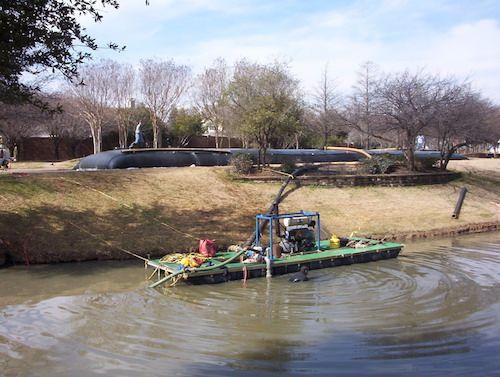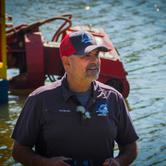Park Pond Dredging: Is Yours Next?

Ponds don't clean themselves, and that's a lesson at least two parks have been learning in recent weeks. Sharon Sheffield Park in Lynn Haven, Florida, and John Sevey Park in Wilbraham, Massachusetts, both began undergoing dredging projects in August.
The latter needs help because storm runoff has sent sediments (sand and other materials) into the pond over the years. Bruuer Pond at John Sevey Park has become "a critical stormwater detention basin for runoff from Monson Road and the Wilbraham Mountains," according to MassLive.com's Conor Berry.
"I think it's going to be healthier after we perform our work," explained Wilbraham Department Works Director Edmond W. Miga Jr.
Storms dating back to 2011 have adversely impacted the health of the pond. In addition to affecting foliage in the area, the inclement weather has also caused erosion on the brook's banks, which spawned sediments along the bottom of Bruuer Pond. As a result, the pond now has a shallower water level that undermines its ability to house wildlife and store additional stormwater.
It's not an unusual phenomenon, nor is there a cheap, overnight solution. The work at Sevey Park was set to take a little over two weeks. Of course, that's nothing compared to Westfield, New Jersey's dredging of Mindowaskin Pond. The project, originally scheduled to begin on or near August 1, is delayed until the Fall once dewatering permits are issued—and it's anticipated to last approximately three months. "It might smell a bit during the process," Town Administrator Jim Galdea said of the Westfield dredging scenario. "It should be a very messy but necessary project."
Meanwhile, Springfield's Gagliarducci Construction Inc. will charge a clean $88,500 to handle the Sevey Park project. In addition to cleaning up the pond, the gig will also involve some landscaping. But when all is said and done, the park should look as good as new.
"You won't see any signs of this," Miga added. "Nature comes back, and it will come back."
The pond project won't be the last work on Sevey Park, either. Additional drainage work and other efforts will likely cost another $1 million next year.
"My staff has been working on this for almost three years," Miga told MassLive.com.
Florida's Sharon Sheffield Park project may be slightly less ambitious but reflects a similar objective. Dirty ponds need help—in this case, removing "debris, old pine straw, and leaves," according to WJHG.com.
"We're only in phase one of the overall renovation efforts for Sharon Sheffield Park," explained Lynn Haven Community Redevelopment Agency (CRA) Director Ben Janke. "[The dredging] has to be done just to maintain the habitat of the flora and fauna in the pond, so it was a no-brainer to put this on the to-do list."
The project at Sharon Sheffield Park should take less time than the Bruuer Pond endeavor.
Pond dredging isn't new, but protecting a healthy habitat and promoting more aesthetically pleasing natural environments has become increasingly important for many local and state governments. To whatever extent there's a public interest in maintaining a pond's health, keeping it clean and safe for wildlife is worth the expense.
That logic inspired Auburn, Michigan, to accept a $62,000 state matching grant in 2014. In that case, the fish population of a 3-acre city pond was jeopardized, and the pond's ability to support once-popular fishing hobbies suffered dramatically.
"We conducted two park surveys, one back in 2007 and more recently one in 2012, and in both instances, pond dredging was a top choice among residents," Auburn mayor Lee Kilbourn told Midland Daily News. "We want to extend the life of the pond. It's been filling in for years, and now is the time to take action so people can have a better fishing experience and enjoy the pond for years to come."
In the 1960s, the artificial pond reached a depth of 50 feet. By 2014, only seven feet of water were at its deepest point. That doesn't just mean less space for the fish to operate. It also endangers their lives.
"The pond gets too hot in the summer and freezes over in the winter, resulting in fish dying due to a lack of oxygen in the water," Kilbourn added. "The pond is a focal point of the city's park, and we're doing our best to upgrade it. Our residents have clarified that they want park upgrades, including better fishing."
Indeed, local residents and their representatives often bring attention to these kinds of pond issues and the dredging projects they necessitate. Some dredging projects are more costly than others—especially after natural events like Superstorm Sandy. That storm sent plenty of sediment into Connecticut's Winnapaug Pond in 2012, necessitating an expensive dredging effort requiring the removal of 32,500 cubic yards worth of sediment from the pond. About 25 percent of that sediment is estimated to have resulted from Sandy.
"It's important to dredge the pond not just for the health of the pond but for tourism, the residents who live there, and aquaculture," argued Misquamicut Business Association executive director Caswell Cooke Jr.
According to The Westerly Sun, the total estimated cost of dredging the pond was as much as $1.9 million. Federal funding and state matching were awarded to offset the expense.
Winnapaug Pond is one of Connecticut's bodies of water requiring a dredging project. Binney Park Pond in Greenwich has accumulated enough silt and litter that it's due for some work. That dredging effort will target 9,500 cubic yards of sediment and attempt to dispose of it off-site in an environmentally friendly way.
"We'll be starting around this time next year, assuming we obtain the budget to do the project," predicted Public Works Deputy Commissioner James Michael. "We believe we can do that."
The same pond was previously dredged back in 1997.
Declining pond dredging, the world's latest trend, might be too soon. Still, it's becoming a reality among many parks, industrial, and residential areas. Broadly defined, dredging simply entails the removal of sediments from the bottom of any body of water. While it can be used to create waterways, improve navigation, or even prepare future construction projects, it's become a commonplace solution when it comes to keeping ponds healthier and less murky.
Though the process has historically been fraught with side effects for the surrounding natural habitat, more recent innovations have spurred a gentler approach.
So, what's changed in recent years? Superior technology and technique have created a far less invasive, more efficient, and environmentally friendly procedure. That win-win situation has changed how many underwater services companies go about dredging, much to the ponds' delight.
American Underwater Services is well-versed in these solutions thanks to its professionally trained specialists and top-shelf equipment. Pond dredging is one of its most tried and true specialties, and it's committed to working with customers to develop projects that meet their unique needs and interests. With a long history of successfully doing these and related jobs, your next pond dredging project need not be a massive headache.
If and when you are in the market for dredging solutions, just remember that a low-impact approach isn't necessarily more expensive. You can do wildlife, vegetation, and the pocketbook a favor at the same time.
Given the availability of cost-effective and environmentally sustainable dredging methods, it's no surprise that parks (and other entities) around the country are making the much-needed investment. Put simply, ponds just can't stay healthy without help.
One key is determining whether your pond would benefit from dredging, and that depends in part on the consistency of its base.
"If your pond has a firm bottom of sand, gravel, clay or bedrock, dredging the soft much on top may provide you with greater depth, reduced nutrients for algae, and more oxygen," explains the Wisconsin Department of Natural Resources, per HobbyFarms.com. "However, if the pond is without a firm bottom, dredging will only deepen the pond and may even increase algae or aquatic plant problems by exposing bottom sediments that contain more available nutrients."
More often than not, however, at least some pond management is in order. Without it, you're leaving nature to its own—sometimes cruel—devices.




